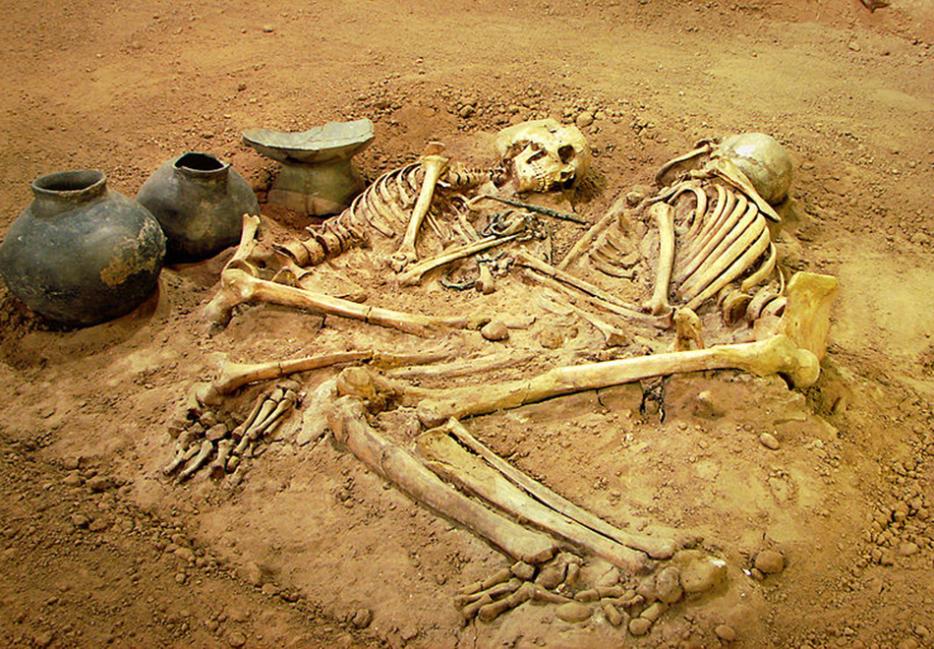Everlasting love is finite. Suppose you meet as teenagers, say at a fateful high school dance; you both look past the streamers and construction paper hearts and recognize your one true love. You hold hands on the ferris wheel, move to a thimble-sized apartment with the bathtub in the kitchen. You make up your own secret handshake, your first child is born. You change careers, you spend a decade in China, come home. You teach your grandkids card tricks, you retire, you hide each others’ dentures as a joke. Then—let’s say—a merciful double diagnosis, time to give away the things you value, time to say goodbye. When the two of you die, holding hands in bed, within breaths of each other, your love will have lasted approximately 60 years. A pretty good run. But what would happen to “’til death do us part” if there were no death?
Science is perpetually on the brink of discovering the cure for aging and death. Last week, Gawker and the New York Daily News reported on the most recent in the centuries-long series of almost-breakthroughs, this time to do with Gabby Williams, a Montana eight-year-old with a long blond ponytail who otherwise resembles a newborn. (The idea is that once they figure out why Williams isn’t aging, with some sophisticated twiddling, scientists can halt the aging process for the rest of us.) In Adam Leith Gollner’s new work, The Book of Immortality: The Science, Belief, and Magic Behind Living Forever, he writes: “Researchers are currently finding clues to longevity everywhere from Texan bat caves (where biochemists are investigating the role of misfolding proteins in long-lived bats) to the soil of Easter Island (where antifungal microbes known as rapamycin can raise the life expectancy of mice by 30 percent or more).” Russian entrepreneur Dmitry Itskov is pouring money into an initiative to make a digital copy of his brain. They’ve already succeeded in replacing a rat’s hippocampus with a microchip; Itskov is planning for a transferable, immortal brain by 2035 or so.
So far, touted “cures” for mortality have bagged us nothing but freezers full of dead Texan millionaires. Noel Coward used to get Swiss doctors to inject him with fetal lamb cells. Mercury pills were once thought to confer eternal life; turns out they kill you instead. Nevertheless, enough people believe that the Gabby Williams gene, or Itskov’s virtual brain upload, or some precise daily intake of yoghurt really is the key to immortality.
Without death, though, it’s not clear whether an immortal life could be recognizably human—our art and religions can largely be reduced to the struggle to comprehend or evade it. We like the idea of cheating death, but how would a life without end retain its meaning?
When art is not about death, it’s about love. In an interview with Vice earlier this spring, philosopher John Fischer said:
The whole idea that somehow love would dissipate if we were immortal, I don’t accept that... Think about this: It’s so painful to lose someone you’ve known as a friend or a lover you’ve been together with for 30 or 40 years, imagine how it would be to lose someone if you’ve been together hundreds of years or thousands of years. That would give more incentive to work at your marriages and your friendships in an immortal life.
Fischer’s insistence that romantic love would survive the death of death feels almost more impossible than cryogenics. It’s hard enough to stay together for a few years, never mind a few thousand. Like a TV show about a group of friends that jumps the shark and keeps going, by the end everyone has slept with everyone and it’s hard to keep straight which loves are supposed to be the important ones. Even if immortal life conferred a certain amount of wisdom, it seems as though the best we could hope for would be a new serial monogamy: the lifespan of a relationship might still be about sixty years.
In part, eternal love is hard to imagine because it seems as though personality itself would be an outmoded concept—for someone to still love you 250 years later, there would need to be a recognizable “you” to love. For a long time, psychologists thought that personality was a set of traits that remained essentially unchanged over a lifetime. Of the Big Five personality traits (extraversion, neuroticism, agreeableness, conscientiousness, and openness), the idea was that you simply were a neurotic or an agreeable person, and that you would stay that way forever. More recently, this idea of an inherently stable personality has been challenged. It seems that while some aspects of our personalities stay the same—if you were an inward-looking 12-year-old, you’ll tend to be an introspective 50-year-old as well—more of us may be up for grabs than previously thought. If your lover went from Jekyll to Hyde and back every thirty years, and you yourself careened from a Woody Allen-esque level of neuroticism to a Dalai Lama calm, it would be hard to say “I” love “you.”
If you lived for thousands and thousands of years, you could play the mandolin like Bill Monroe, write huaigu like Li Bai, undergo enough plastic surgery to live inside every face under the sun. You could go everywhere and know everything. (You could also spend eternity watching reruns of The Golden Girls and weeping for your inability to end the meaningless parade of living, but even being bored of life would get boring.) Crucially, you could understand what it’s like to be any possible kind of person.
But maybe the increased possibility of change would work for everlasting partnership rather than against it. Love between immortals would be freed of some of the pressures of mortal love—with all the time in the world to have children (well, presumably most of us would need to be sterilized to avoid overrunning the planet, but let’s stay in thought experiment mode for now), develop satisfying careers, and see our families and friends, we wouldn’t need to do such rigorous cost-benefit analysis of the time and energy it takes to maintain a relationship. You could concentrate for 40 years on learning how to tell when your partner needs you there and when they want to be alone. You could spend an eon learning how to kiss.
As Gollner points out, despite all the talk of stem-cells and computer-chip mouse brains, there’s really no reason to believe we’re any closer to immortal life than we were when we first started searching for it—millennia ago. At a Shambhala centre in Montreal, Gollner remarks on a particular passage in his photocopied handout: “Sickness is my companion; it follows me everywhere...Death is my friend, the truest of friends, a true friend that never abandons me. Death is always waiting for me.” Right now, our pursuit of immortality is an impossible, imaginary love affair; the marriage that lasts for 60 years is still the closest we can get to the everlasting.
But thinking about eternal life can still teach us something about ourselves. We’re often advised to live as if we might die tomorrow—it’s counsel that favours the impulsive, the hedonistic, and, maybe, the selfish. If we lived as if we might live forever, maybe we would take better care of our relationships. Taking the long, long, long view could help us love each other more patiently.
Every week, Linda Besner reads a new book and writes on a tangentially related topic.






